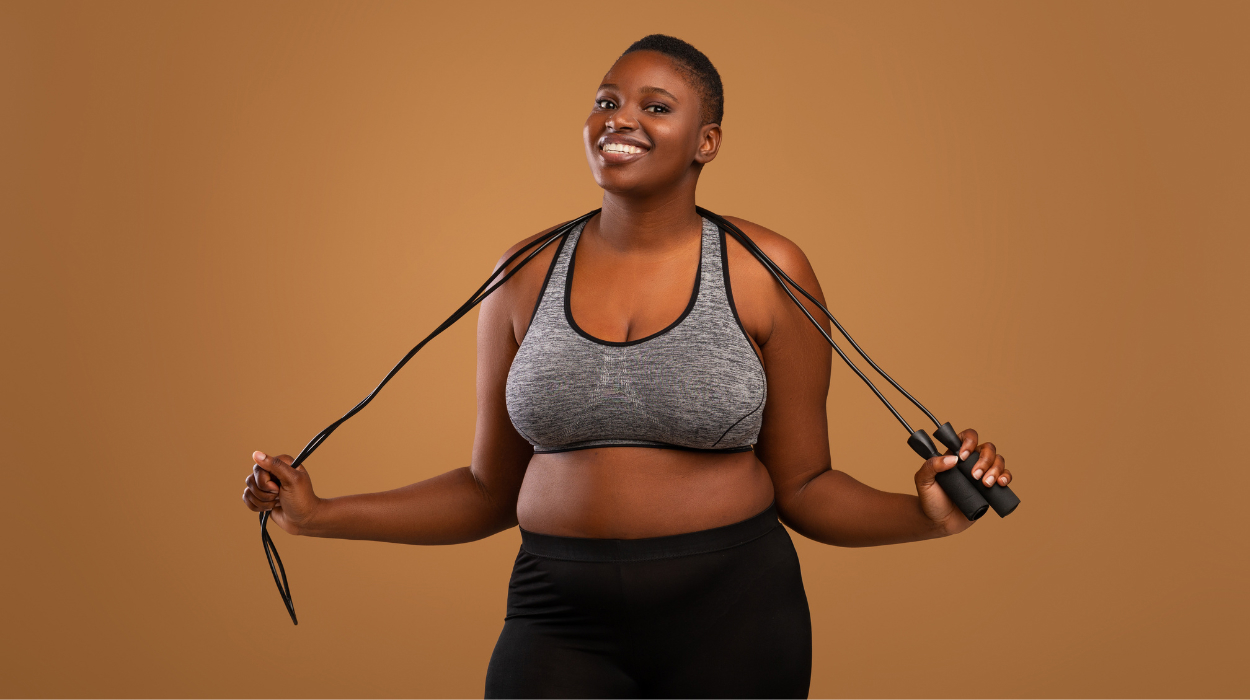Looking to shed some pounds and wondering, “How long should I jump rope to lose weight?” Jump rope workouts have gained immense popularity as a potent means of torching calories and aiding weight loss. Whether you’re a fitness enthusiast or a newbie, incorporating a jump rope into your routine can be a game-changer.
This simple yet dynamic exercise not only elevates heart rate but also serves as a fantastic fat burner. Let’s dive into the specifics of jump rope workouts and their efficacy in achieving weight loss goals.
Does Jumping Rope Make You Lose Weight?
Yes, jumping rope can help you lose weight. Jumping rope allows you to efficiently burn calories, which will help put you in a calorie deficit. When the body is in a deficit, it burns stored fat for energy.
How Long Should You Jump Rope To Lose Weight?

How long should you jump rope? Jump roping is a very good fat burner.
The amount of time you should spend jumping rope varies based on individual factors like weight, intensity, and overall fitness goals. However, there are a few general guidelines you can use.
For most people, 15 to 30 minutes of continuous jump roping is a good range for effective weight loss. This time frame allows your body to engage in sustained cardiovascular activity, effectively burning calories and targeting fat stores. Ideally, you should start with around 15 minutes and increase to 30 minutes as you become used to the workout.
Consistency matters when it comes to jump rope weight loss. It’s not just about the time spent jumping rope. The intensity and maintaining a steady rhythm throughout the workout are also important.
Jump rope workouts are very adaptable, so you can modify them based on your fitness level. This allows you to progress as your endurance improves gradually. You can also alternate periods of high and low intensity, giving even better results.[1]
You also want to remember that comparing yourself to others on their weight loss journeys will only hinder you mentally. Everyone starts in a different place and has varying strengths and weaknesses. Recognize your abilities, and focus on being a little better every week.
While jumping rope is a simple task, it is challenging. However, sticking with it and increasing the intensity over time will likely contribute to your weight loss goals.
How Many Calories Does Jumping Rope Burn?
Jumping rope burns a remarkable amount of calories.
On average, a 150-pound person can burn about 200 to 300 calories in a 15-minute session. However, the more vigorous and continuous the jumping, the more calories you’ll burn. Combined with calorie restriction, it can also improve heart health[2] and lower the risk of some cancers.[3]
Jump roping is high-intensity, elevating your heart rate and engaging multiple muscle groups simultaneously, making it a full-body workout. Using multiple muscles burns more calories, so compared to many other cardiovascular exercises, skipping rope is better for losing weight. Some studies suggest that jumping rope may be a more effective exercise[4] than running, for example.
Jumping rope to lose weight can also help rev up your metabolism. This means your body continues to burn calories[5] even after you’ve finished jumping rope. This will aid in the overall goal of shedding pounds.
When you’re trying to learn how to lose weight, remember to complement it with a balanced diet and other workouts for holistic results. Combining jump rope sessions with strength training or other cardio exercises can further enhance calorie burn and accelerate weight loss.
Overall, jumping rope is an effective full-body workout that burns many calories and aids in losing weight. t. Its efficiency in torching calories, combined with its versatility and accessibility, makes it a valuable tool to support weight loss. This is especially true when integrated into a well-rounded fitness routine.
Benefits Of Jumping Rope

Cardiovascular Health
Jumping rope elevates heart rate, enhancing cardiovascular endurance while improving overall heart health. Its rhythmic nature provides a sustained cardio workout that can be tailored to meet the needs of all fitness levels. It can also be more intense than other workouts, such as running, which may be more effective for heart health.
Jumping rope uses both your upper and lower bodies, working numerous muscle groups. Different muscle groups have varying effects on heart health,[6] so getting both at once can help you balance your cardio.
Enhanced Coordination
Jumping rope demands coordination between hands and feet, enhancing overall agility, balance, and motor skills.[7] This practice in coordination can extend to greater coordination for the rest of your life. You’ll also have an improved sense of balance.
Burning Calories
How long does it take to lose weight?[8] That depends on the exercise, but jumping rope burns more calories by using a variety of muscles at once. So, jumping rope might help you lose weight faster than many other forms of exercise.
Jumping rope usually builds lean body mass, particularly in the thighs and calves.[9] This does several things.
Adding muscle creates a more toned and attractive look, even with the same amount of fat. Muscle also requires more energy to maintain, so your resting metabolic rate[10] will increase the more muscle you have.
Convenience And Portability
Jump ropes offer a convenient fitness tool for jump rope workouts on the go or at home. For example, you can jump rope in the parking lot on your lunch break. You could also do it in your hotel while traveling or at rest stops on a road trip.
You can take a jump rope anywhere, so anywhere can be a workout zone. Try doing that with a treadmill.
Jump Rope Workout For Weight Loss
Creating an effective jump rope workout for weight loss involves balancing duration, intensity, and variation. Let’s delve into a recommended routine that optimizes calorie burn and contributes to shedding pounds effectively.
This routine uses high-intensity interval training, which involves using periods of high-intensity exercise and periods of rest or low intensity. High-intensity interval training, or HIIT, has been shown to have greater cardiovascular effects[11] than consistent, medium-intensity exercise.
Begin with a dynamic warm-up to prime your muscles and boost circulation, reducing the risk of injury. Then, start with a basic jump for about three minutes. Take it slowly and at a fairly low intensity — this section is your build-up to the rest of the workout.
Transition into high knees by lifting your knees higher with each jump for another two minutes. Next, land with one foot in front of the other, alternating which foot, for two more minutes. These more intense moves increasingly add intensity and challenge.
Finally, try double unders, where you turn the rope extremely fast so it passes beneath your feet twice for each jump. This is one of the most challenging jump rope moves. Try doing it for only one high-intensity minute.
Then, you should take a break. Ideally, rest for one minute, but you may need more. Make sure to drink some water and rehydrate during this break. Try to get your breathing to a normal level.
Repeat the sequence two or three times. Then, finish with a stretching cooldown to lower your heart rate gradually, improve muscle recovery, and train flexibility. Assuming you spend five minutes each on the warm-up and cooldown, this routine should take thirty or forty minutes.
However, you should note that one study found that a more playful approach to jumping rope showed more benefits.[12] Students who were allowed to jump rope in whatever way they chose and to try new styles had better calorie burning, flexibility, and bone strength. This study was done on children, but it will likely apply to everyone.
Conclusion
Jumping rope is a versatile and effective tool for shedding pounds when incorporated into workouts. Combine it with a balanced, healthy diet to maximize results, and consider supplements as well. Consistency is key; gradually increase the duration and intensity of jump rope sessions for better outcomes.
Consider using high-intensity interval training for optimal effects. It’s great for heart health and weight loss. Plus, if you’re skipping rope, it’s very easy to adjust the intensity as needed.
Jumping rope for weight loss is a potent addition to workouts, burning more calories and targeting fat effectively. Pair it with a healthy diet and varied workouts for the best results. This will help with shedding fat and water weight and achieving a leaner body mass.
Frequently Asked Questions
Aim for 15 to 30 minutes of continuous jumping rope to aid in weight loss effectively. If you’re using intervals instead of continuous exercise, you should still try to jump for 15 to 30 minutes, including break intervals.
Yes, jumping rope daily can contribute to weight loss if paired with a healthy diet and other workouts. You should try to include variety in your workouts. Since jumping rope is cardio, try to add resistance training to round out your fitness routine.
While beneficial, 10 minutes might not be sufficient for substantial weight loss. If you’re doing a very high-intensity workout, 10 minutes might be all you can manage, but you should rest between exercises to go for longer.
Jumping rope can help reduce overall body fat, including belly fat when combined with a comprehensive fitness routine and healthy diet. Diet pills might also help.
 Expert's opinion
Expert's opinion
